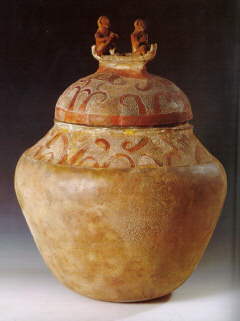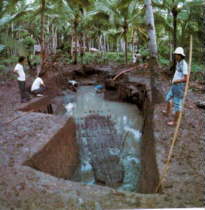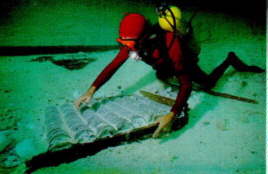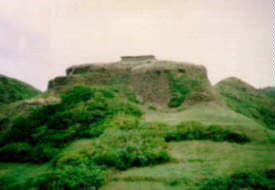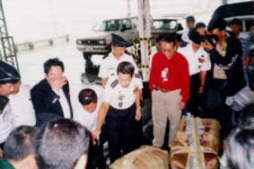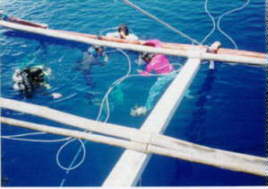The Pinagmulan exhibition capsulizes Philippine prehistoric research to date. It starts with the geologic formation of the archipelago, then the Paleolithic Period, Austronesian movement, Neolithic Period, Metal Age, trade goods and luxury goods (carnelian, jade and glass), pottery, Asian trade, Butuan boat, international trade, conservation of underwater materials, a featured site (Batanes Archaeological Project), and general/basic archaeology.2. Archaeological Treasures (Kaban ng Lahi) Maitum, Manunggul, etc.)
Features the Maitum Anthropomorphic Potteries, the Manunggul Jar, Leta-leta potteries from Palawan, limestone urns from Kulaman Plateau, Cotabato and gold artifacts.
| Maitum Anthropomorphic Potteries
The anthropomorphic secondary burial jars from Pinol, Maitum, Saranggani Province in Mindanao date back to the Metal Age. The site had been dated to 830 +/-60 B.P. (calibrated date of A.D. 70 to 370) and 1920 +/- 50 B.P. (cal. date of 5 B.C. to A.D. 225). The radiocarbon dates were obtained from the soot samples taken from the small earthenware vessel found inside one of the anthropomorphic burial jar. These burial jars are made of earthenware designed and formed like human figures with complete facial characteristics. These were associated with metal implements; glass beads and bracelets; shell spoon, scoop, bracelets and pendants; earthenware potteries with incised designs and cut-out foot-rings; non-anthropomorphic burial jars. |

Anthropomorphic Burial Jars |
| Manunggul Jar
|
The Manunggul Jar was recovered at Chamber A of Manunggul Cave in Palawan.
It is an elaborately designed burial jar with anthropomorphic figures on
top of the cover that represent souls sailing to the afterworld in a death
boat. The figure on the rear is holding a steering paddle with both
hands; the blade of the paddle is missing. Both figures appear
to be wearing a band tied over the crown of the head and under the jaw.
The manner in which the hands of the front figure are folded across the
chest is a widespread practice in the Philippines and Southeast Asia when
arranging the corpse.
The prao is carved like a head with eyes, nose, and mouth. This motif of carving is still found on the traditional sea vessels of the Sulu Archipelago, Borneo, Malaysia. The execution of the ears, eyes, and nose has similarities with the contemporary woodcarvings of Taiwan, the Philippines, and many areas in Southeast Asia. It is dated to as early as 710 - 890 B.C. The Manunggul jar was declared a National Treasure and its portrait is on the 1000 Philippine peso bill. |
Leta-leta cave archaeology
Leta-leta Cave, Langen Island, El Nido, Palawan was excavated in 1965 by Dr. Robert Fox. Leta-leta Cave is an important burial site belonging to the Late Neolithic Period where an assemblage of stone and shell artifacts associated with sophisticated pottery and nephrite adzes and axes were recovered. Other materials include stone ornaments and shell beads.
|
 Shell Scoop Shell Scoop |
